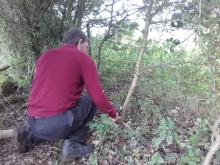We are now into autumn and those of us who are regularly out and about in the Churnet will have noticed some changes – the fungi are starting to make themselves known, the migrant birds are disappearing and soon I suspect we’ll be hearing the tell-tale chattering of fieldfare and the high pitched whistle of redwings. If nothing else the berries and crap apples are in full force.
With the onset of autumn the volunteers and I are turning our hands to new tasks. This week we have been out hedge laying near Stanton. Laying is a traditional way of managing hedges before the onset of wire fences and tractor propelled flail mowers. Laying produces a thick, dense hedge that regrows with great vigour meaning that some of our hedges may consist of plants that have been rooted in our countryside for centuries. The change in season means the trees and shrubs in the hedge are no longer in their active growth phase and so pruning and pleaching them will not have a long term detrimental effect.
First you trim one side of the hedge back until you can see the neat, straight stems - neat, straight stems are often few and far between so you have to select the best ones and remove the more ugly ones. Then you carefully use a billhook to “pleach” the remaining stems so they can be safely bent over to lie on top of one another in a dense barrier. You then use stakes to hold them firmly in place and twist and tangle branches into one another to keep the whole thing nice and tight.
It’s an opportunity to break out some good old traditional tools like billhooks of which there are numerous shapes and sizes each going back to a traditional style linked to different areas of the country – Staffordshire has its own style, although I have to admit we don’t have one in our arsenal. We also use carving axes and brushing hooks, tools that haven’t really changed in a thousand years. The art of laying hedges hasn’t changed that much in all that time either and again each area of the country has its own style of laying with different flourishes and finishes.
The new growth from the base and from the cuts made higher up will form a vigorous, thick and appealing hedge that both keeps the sheep and cattle where they need to be and supports an array of wildlife alongside our working farmed landscapes. Specialist farmland birds like tree sparrows and yellowhammer that have suffered huge declines in the past few decades can benefit from well kept hedges as nesting and feeding habitat. It’s also great to apply a traditional skill alongside the ever enthusiastic volunteers and make sure that the skill lives on in a meaningful way – even if it is little disconcerting seeing pat with a rather large billhook and a grin.




